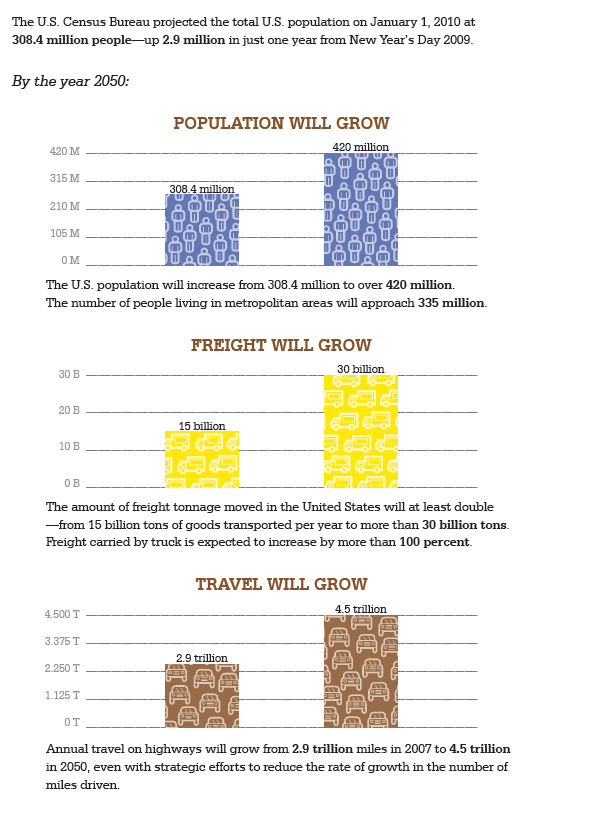AMERICAN ASSOCIATION OF STATE HIGHWAY AND TRANSPORTATION OFFICIALS
Unlocking Gridlock: Key Findings
Significant investment is needed to keep America moving.
- Travel on the U.S. highway system has increased five-fold over the past 60 years from 600 billion miles driven to almost three trillion in 2009.
- Annual travel is expected to climb to nearly 4.5 trillion miles by 2050, even with aggressive strategies to cut the rate of growth to only one percent per year.
- Drivers with a 30-minute commute lose 22 hours (nearly three full work days) annually sitting in traffic.
- The U.S. Department of Transportation’s 2008 Conditions and Performance report , released in early 2010, projects an annual highway investment need of about $175 billion. Of that amount, $85 billion is needed for system rehabilitation, $71 billion is needed for system expansion and $18 billion is needed for system enhancements such as safety improvements.
- If most or all of our capital investments were made in system rehabilitation and little to none in adding needed capacity, the condition of the nation’s roads and bridges would improve, but traffic would grind to a halt.
The Interstate Highway System is the backbone of the nation’s transportation network and must continue to play a strategic role.
- Representing only one percent of total highway miles, today’s Interstates carry 24 percent of all traffic and 41 percent of combination-vehicle truck traffic.
- Between 1980 and 2006, traffic on the Interstate System increased by 150 percent, while Interstate capacity increased by only 15 percent.
- Because capacity has not kept pace with travel demand over the past four decades, the amount of traffic experiencing congested conditions at peak hours in the nation’s most urban areas on the Interstate System doubled from 32 percent to over 67 percent.
- In many metro areas, the bulk of traffic is carried on urban Interstates and state arterials, rather than on city and county arterials or local streets. For example, in the Austin, Texas metro area, only seven percent of the highway network is made up of state arterials and Interstates, but those roads carry 80 percent of the traffic.
Meeting metropolitan mobility needs will require a balanced approach that preserves what has been built to date, improves system performance, and adds substantial capacity in highways, transit, freight rail, and intercity passenger rail.
- Highways play a dominant role in providing mobility for the American public, carrying 95 percent of passenger trips and 93 percent of freight by value. Expanding highway capacity is not the only thing that will be required to meet future mobility needs, but it will be a principal part of what is needed.
- To reduce current congestion and meet future needs, the AASHTO 2007 Future Options for Interstate Highways study found that the equivalent of 30,000 additional lane-miles should be added to the existing 85,000 lane-miles of urban Interstate. Additionally, another 40,000 lane-miles need to be added to the existing urban segments of the National Highway System.
- AASHTO has also called for doubling transit ridership by 2030, and increasing federal transit assistance by 89 percent. AASHTO has also called for investing $50 billion in high speed and intercity passenger rail during the next six years.
- Massive investments in transit capacity and a quadrupling of transit ridership cannot substitute for additional increases in Interstate highway capacity needed to accommodate longer distance passenger and freight movements and the through-trips that continue to grow.
- AASHTO has called on Congress to provide $375 billion over the next six years in federal highway assistance, 90 percent distributed by formula to the states. A significant portion of these funds should be provided to fund the Interstate Highway capacity needed. These dollars should be systematically programmed by states and their MPOs to meet community needs, especially the needs for increasing metropolitan mobility and reducing congestion.
AASHTO’s four-pronged approach to restarting America’s most essential operating system—its transportation network:
- Preserve and modernize the system.
- Improve system performance.
- Shift trips to other options, such as intercity passenger rail, transit, bicycles or walking; and shift freight from trucks to rail.
- Add the highway capacity needed to sustain America’s future.
Download full report (PDF): Unlocking Gridlock
About American Association of State Highway and Transportation Officials
www.aashto.org
“The American Association of State Highway and Transportation Officials is the voice for transportation and catalyst for organizational and technical excellence…AASHTO advocates transportation-related policies and provides technical services to support states in their efforts to efficiently and safely move people and goods.”
Tags: AASHTO, American Association of State Highway and Transportation Officials, Gridlock







 RSS Feed
RSS Feed